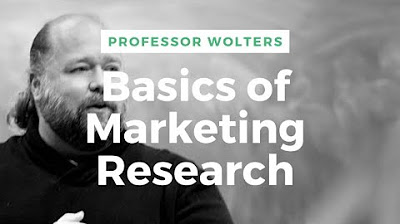What is Strategic Marketing?
Summary
TLDRIn this video, Professor Wolters delves into the concept of marketing strategy, emphasizing its importance as a plan of attack to win in the market. He discusses the marketing mix, including product, price, place, and promotion, and the need to adapt to market demands and competition. The video highlights the significance of understanding customer value, choosing the right distribution channels, and timing product releases. It also touches on the importance of communication in conveying product value and differentiating from competitors, ultimately aiming for a sustainable competitive advantage.
Takeaways
- 📘 Marketing Strategy Defined: It's a plan of attack to win in the market by reaching out to customers and communicating effectively.
- 🚀 Importance of Planning: A marketing strategy is essential for figuring out how to succeed with a product or in a specific industry niche.
- 🛍️ Product Consideration: The strategy involves deciding what products or services to offer that customers will find valuable and be willing to purchase.
- 💰 Pricing Strategy: Determining the value of products in the target market and communicating the reasons behind different price points is part of the strategy.
- 📍 Place Strategy: Choosing the right distribution channels and locations for products can affect perceptions and sales.
- 📅 Timing is Key: Deciding the optimal release date for products or services can significantly impact their success in the market.
- 🤝 Communication Strategy: A crucial part of marketing strategy is how to effectively communicate about the new product, its pricing, and its value proposition.
- 🔍 Analyzing the Market: A successful strategy takes into account customers, competition, and the industry to develop a competitive advantage.
- 📱 Mobile Phone Example: The script uses mobile phones to illustrate how different market segments have unique needs and how strategies must be tailored accordingly.
- 🔄 Adaptability: Marketing strategies are not set in stone; they must be flexible to adapt to changes in the market or competition.
- 🛠️ Strategic Planning Tools: The script suggests using various strategic planning models, such as SWOT analysis and the five forces, to inform marketing strategies.
Q & A
What is the main focus of the video script provided?
-The main focus of the video script is to explain the concept of marketing strategy, how it is a plan of attack to win in the market, and how it involves various aspects of the marketing mix such as product, price, place, and promotion.
What is the definition of marketing strategy according to the script?
-According to the script, a marketing strategy is a plan to reach out to customers, figure out where to sell products or services, and how to communicate with those customers effectively to succeed in the market.
How does the script relate the concept of marketing strategy to the marketing mix?
-The script relates marketing strategy to the marketing mix by stating that it involves taking the marketing mix components—product, price, place, and promotion—and creating a plan to succeed with them in the market.
What is the importance of understanding the target market's perception of value in pricing strategy?
-Understanding the target market's perception of value is crucial in pricing strategy as it helps determine the right price point that the market is willing to pay for the product or service, which is part of the overall marketing strategy.
Why is it important to consider the location or place when developing a marketing strategy for a new computer?
-The location or place is important because it can influence consumer perception. For example, selling a computer at Best Buy might make it seem more advanced than selling it at Walmart, which is part of the strategic decision-making process.
How does the script use the example of movie release dates to illustrate the importance of timing in marketing strategy?
-The script uses the example of movie release dates to show that timing is a strategic decision that can affect the success of a product. Releasing a movie at different times of the year can cater to different audience behaviors and preferences.
What factors should be considered when developing a marketing strategy according to the script?
-Factors to consider when developing a marketing strategy include understanding the customers, analyzing the competition, considering the industry trends, and planning the communication strategy to effectively promote the product or service.
How does the script suggest that a marketing strategy should be flexible?
-The script suggests that a marketing strategy should be flexible by comparing it to a GPS, which gives a route but allows for detours or changes in plans when faced with unexpected challenges or opportunities.
What is the role of a marketing strategy in achieving a competitive advantage?
-A marketing strategy plays a crucial role in achieving a competitive advantage by helping a company focus its efforts, understand its target market, and differentiate itself from competitors in a way that is sustainable over time.
How does the script use the example of mobile phones to explain the concept of niche marketing?
-The script uses the example of mobile phones to explain niche marketing by discussing how companies like BlackBerry targeted the business market with specialized features, and how the strategy had to evolve with changing market conditions and the rise of smartphones.
What is the significance of identifying the target market for a mobile phone company according to the script?
-Identifying the target market is significant because it helps the company tailor its products and services to meet the specific needs and preferences of that market segment, whether it's for personal use, business, or specialized industries.
Outlines

This section is available to paid users only. Please upgrade to access this part.
Upgrade NowMindmap

This section is available to paid users only. Please upgrade to access this part.
Upgrade NowKeywords

This section is available to paid users only. Please upgrade to access this part.
Upgrade NowHighlights

This section is available to paid users only. Please upgrade to access this part.
Upgrade NowTranscripts

This section is available to paid users only. Please upgrade to access this part.
Upgrade NowBrowse More Related Video

The Basics of the Marketing Research Process

Basics of Marketing Research

What is Service Marketing & Why is it so important to the Economy?

Concept Testing, Alpha Testing, & Beta Testing Explained

Typical Sales Promotions & How Firms Use Them to Get You to Buy

Why Firms Need a New Digital 1st Approach to Marketing
5.0 / 5 (0 votes)